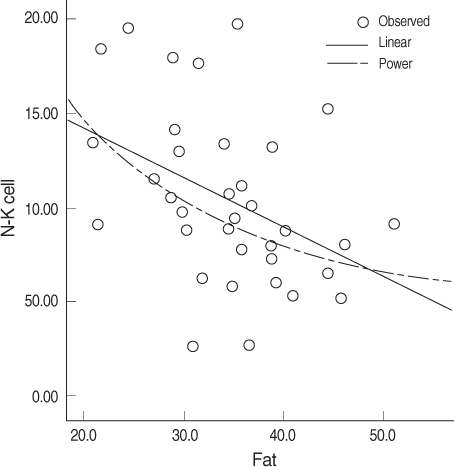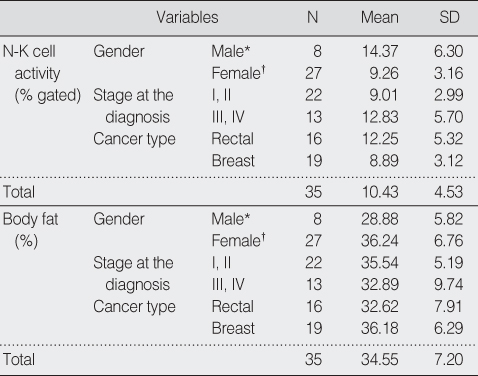Articles
- Page Path
- HOME > J Korean Acad Nurs > Volume 38(2); 2008 > Article
-
Original Article
- Body Fat Percentage and Natural Killer Cell Activity of Breast and Rectal Cancer Patients after Diagnosis but before Treatment
- Dal Sook Kim, Myung Hee Jun
-
Journal of Korean Academy of Nursing 2008;38(2):321-331.
DOI: https://doi.org/10.4040/jkan.2008.38.2.321
Published online: April 30, 2008
1Professor, Department of Nursing, Chungnam National University, Daejeon, Korea.
2Professor, Department of Nursing, Daejeon University, Daejeon, Korea.
- Address reprint requests to: Kim, Dal Sook. Department of Nursing, Chungnam National University, 6 Munhwa-dong, Jung-gu, Daejeon 301-747, Korea. Tel: 82-42-580-8327, Fax: 82-42-584-8915, dskim@cnu.ac.kr
Copyright © 2008 Korean Society of Nursing Science
Abstract
-
Purpose
- To examine the relationship between body fat percentage (BFP) and N-K cell activity (NKCA) in Korean breast and rectal cancer patients just after diagnosis.
-
Methods
- With 35 subjects enrolled between November 2002 and May 2003, Bioelectrical Impedance Analysis was used to estimate BFP. FACS Analysis was used to measure N-K cell activity. The relationships between BFP and NKCA were identified by using curve estimation, simple regression, and multiple regression.
-
Results
- The mean BFPs of the subjects and all the sub-groups were higher than acceptable BFPs. Both the mean NKCAs of male and female subjects were lower than that of healthy women. NKCA was explained by BFP with a 14.9% variance in the total subjects (p<.05). There were significant negative relationships between BFP and NKCA after controlling age, type of cancer, and stage of cancer while no significant relationship was found after controlling for gender. The relationships between BFP and NKCA in the sub-groups of female, breast cancer, and stage I, and II were significant. The relationships between male, rectal cancer, and the stage III, and VI sub-groups were not identified, but they revealed a mild to moderate steep in curve estimation.
-
Conclusion
- Weight reduction could prevent the risk and advancement of breast and rectal cancer in Koreans.
This work was supported by grant No R04-2002-000-00077-0 from the Basic Research Program of the Korea Science & Engineering Foundation.
- 1. Ahn SH, Park KC, Youn YY, Lee MS, Kim YS, Kim MK. A case- control study on the risk factors of breast cancer in Korea. Journal of Korean Surgical Society. 1996;50:26–35.
- 2. What are the risk factors of breast cancer. American Cancer Society. 2007;10;Retrieved October 22, 2007. from the American Cancer Society, Web site: http//www.cancer.org/docroot/CRI.
- 3. Bovbjerg DH, Valdimarsdottir HB, Zachariae R. Scheldlowski M, Tewes U. Psychoneuroimmunology in oncology. In: Psychoneuroimmunology: An interdisciplinary introduction. 1999;. New York, Kluwer Academic Plenum Publishers. 473–486. .
- 4. Abdominal fat affect breast cancer survival. Breast cancer news. 2006;10;Retrieved July 26, 2007. from the Breast Cancer News, the Medical News Today Web site: http://www.medicalnewstoday.com.
- 5. Dhabhar FS, McWen BS. Ader R, Felton DL, Cohen N. Bidirectional effects of stress and glucocorticoid hormones on immune function: Possible explanations for paradoxical observations. In: Psychoneuroimmunology. 2001;vol 2:3rd ed. San Diego, Academic Press. 301–338.
- 6. Draper L. Breast cancer: trends, risks, treatments, and effects. Official Journal of the American Association of Occupational Health Nurses. 2006;54:445–451.
- 7. A woman's body type and the risk of breast cancer. Fact sheet #42. 2001;08;Retrieved July 26, 2007. from program on breast cancer and environmental risk factors, Sprecher Institute, Cornell University Web site: http://envirocancer.cornell.edu/FactSheet/General.
- 8. Feigelson HS, Patel AV, Teras LR, Gansler T, Thun MJ, Calle EE. Adult weight gain and histopathologic characteristics of breast cancer among postmenopausal women. Cancer. 2006;107:12–21.ArticlePubMed
- 9. Breast cancer. Health Information Publications. 2002-2005;Retrieved July 26, 2007. from the EhealthMD Web site http://www.ehealthmd.com..
- 10. Understanding your body fat percentage. Health Check Systems. 1997;07;Retrieved July 26, 2007. from the Health Check Systems Web site:http://www.healthchecksystems.com..
- 11. Kelley DS, Daudu PA, Branch LB, Johnson HL, Taylor PC, Mackey B. Energy restriction decrease number of circulating natural killer cells and serum levels of immunoglobulins in overweight women. European Journal of Clinical Nutrition. 1994;48:9–18.PubMed
- 12. Kim DS. Comparison of N-K cell level between normal person and the cancer patients just after diagnosis. Chungnam Journal of Nursing Academy. 2005;8(2):27–32.
- 13. Kim EK, Yang YH, Choi KS. Nutritional Status of Cancer Patients upon Admission. Journal of Korean Society of Nursing Science. 1999;29:272–280.
- 14. Lamas O, Martinez JA, Marti A. Energy restriction restores the impaired immune response in overweight (cafeteria) rats. The Journal of Nutritional Biochemistry. 2004;15:418–425.ArticlePubMed
- 15. Lee SA, Yoo KY, Noh DY, Choe KJ. Diet and the risk of breast cancer in Korean women- a case-control. Journal of Korean Breast Cancer Society. 2003;6:271–276.
- 16. Lee HS, Kim Y. SPSS 10.0 Manual: Statistical analysis and interpretation. 2001;Seoul, Beop-Mun Co.
- 17. Macinnis RJ, English DR, Haydon AM, Hopper JL, Gertig DM, Giles GG. Body size and composition and risk of rectal cancer (Australia). Cancer Causes & Control. 2006;17:1291–1297.ArticlePDF
- 18. Nieman DC, Henson DA, Nehlsen-Cannarella SL, Ekkens M, Utter AC, Butterworth DE, et al. Influence of obesity on immune function. Journal of the American Diet Association. 1999;99:294–299.Article
- 19. Popkin BM. Understanding global nutrition dynamics as a step towards controlling cancer incidence. Nature reviews. Cancer. 2007;7:61–67.PMC
- 20. Scanga CB, Verda TJ, Paolone AM, Andersen RE, Wadden TA. Effects of weight loss and exercise training on natural killer cell activity in obese women. Medicine and Science in Sports and Exercise. 1998;30:1666–1671.ArticlePubMed
- 21. Schag CC, Heinrich RL, Ganz PA. Karnofsky performance status revisited: Reliability, validity, and guidelines. Journal of Clinical Oncoloy. 1984;2:187–193.Article
- 22. Semaninc C, Chow WH, Gridley G, Jarvholm B, Fraumeni JF. Relation of body mass index to cancer risk in 362,552 Swedish men. Cancer Causes & Control. 2006;17:901–909.ArticlePDF
- 23. Shade ED, Ulrich CM, Wener MH, Wood B, Yasui Y, LACroix K, et al. Frequent intentional weight loss is associated with lower natural killer cell cytotoxicity in postmenopausal women: possible long-term immune effects. Journal of American Diet Association. 2004;104:903–912.Article
- 24. Sothern RB, Roitman-Johnson B. Ader R, Felton DL, Cohen N. Biological rhythm and immune function. In: Psychoneuroimmunology. 2001;vol2:3rd ed. San Diego, Academic Press. 445–482.
- 25. Turner-Cobb JM, Sephton SE, Spiegel D. Ader R, Felton DL, Cohen N. Psychosocial effects on immune function and disease progression in cancer: Human studies. In: Psychoneuroimmunology. 2001;vol 2:3rd ed. San Diego, Academic Press. 565–582. .
- 26. Wang S, Lee N. Comparison of body fat by biological impedance analysis and anthropometric measurements in women in Daejeon. Korean Journal of Life Science. 2004;13:1037–1046.
- . Yabro CH, Frogge MH, Goodman M, Groenwald SL. Cancer Nursing: Principles and Practice. 2000;Boston, The Jones and Bartlett Series.
REFERENCES

Figure & Data
REFERENCES
Citations

- Factors influencing quality of life in post-menopausal women
Hyunsook Shin, Eunjoo Lee
Korean Journal of Women Health Nursing.2020; 26(4): 336. CrossRef - Women's Cancer Screening According to Body Mass Index in a Cohort of Rural Korean Women
Bo Hwan Kim, Sang Baek Koh, Hea Kung Hur, Jong-Ku Park, So Mi Park
Journal of Korean Academy of Nursing.2009; 39(5): 641. CrossRef

Figure 1
Descriptions of Natural Killer Cell Activity and Body Fat Percentage
*comprising 8 stage III, IV rectal cancer patients; †comprising 17 stage I, II breast cancer patients, 2 stage III, IV breast cancer patients, 5 stage I, II rectal cancer patients, and 3 stage III, IV recral cancer patients.
Relationships between Total Body Fat (%) and N-K Cell Activity (% gated) in Linear Regression Models
*for the total subjects (N=35); †for the female subjects (N=27); ‡for the breast cancer patients (N=19); §for the subjects at the stage I, II (N=22).
Relationships between Body Fat (%) and N-K Cell Activity (% gated) in Age, Gender, Type of Cancer, and the Stage at Diagnosis Controlled (N=35)
*comprising 8 stage III, IV rectal cancer patients; †comprising 17 stage I, II breast cancer patients, 2 stage III, IV breast cancer patients, 5 stage I, II rectal cancer patients, and 3 stage III, IV recral cancer patients.
*for the total subjects (N=35); †for the female subjects (N=27); ‡for the breast cancer patients (N=19); §for the subjects at the stage I, II (N=22).
 KSNS
KSNS
 E-SUBMISSION
E-SUBMISSION



 Cite
Cite

